|
Native Galaxiid fish |
Kokopu, Inanga & Koaro |
 |
| |
2008 IUCN Red List of Threatened Species
Black mudfish
Neochanna diversus
Data deficient
Brown mudfish
Neochanna apoda
Vulnerable
Canterbury mudfish
Neochanna burrowsius
Vulnerable
Chatham mudfish
Neochanna rekohua
Vulnerable
Dwarf galaxias
Galaxias divergens
Vulnerable
Dwarf inanga
Galaxias gracilis
Vulnerable
Giant kokopu
Galaxias argenteus
Vulnerable
Shortjaw kokopu
Galaxias postvectis
Vulnerable |
| |
|
|
NEW ZEALAND ECOLOGY |
| |
|
|
NATIVE GALAXIID FISH |
| |
|
The 24 species of the Galaxiidae family, with 19 of the Galaxias genus and 5 Neochanna species, make up a large part of New Zealand's distinctive but sparse freshwater fish fauna of 35 native species. Only two Galaxias species of the family are not endemic. Diadromey in half of the species in the New Zealand fauna is the strongest characteristic of all major elements of it. Five Galaxiids are amphidromous, a migratory life cycle in which eggs hatch in the lower river and larvae are washed out to sea in Autumn, where they grow into whitebait before entering the estuary in Spring, and then climb upstream to mature. |
| |
 |
|
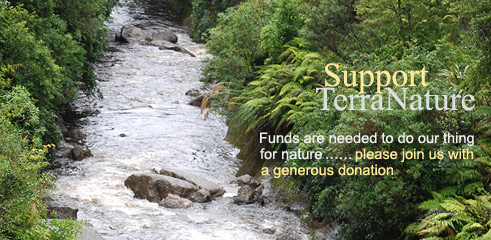 |
| |
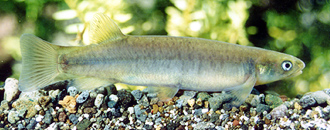 |
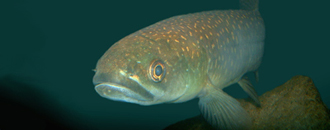 |
| |
|
Endemic shortjaw kokopu are the rarest of the five whitebait species. Little is known about this secretive, nocturnal fish as it was rarely found until new populations were recently discouvered. As its' name suggests, the lower jaw is shorter than the upper jaw, a feature shared with koaro. The shortjaw has plain blotched brown colouring with faint bands, and a black patch behind the gills. They climb to rock-bottomed streams and prefer vegetation cover.
 MORE MORE |
|
|
The giant kokopu is endemic, was the first Galaxiid to be identified in 1789 (Gmelin), and is the largest of the Galaxiidae family. Giant kokopu can grow to 45 cm, but 20 to 30 cm is more usual. It is one of the five whitebait fish but is not commonly found in the catch, perhaps because it runs later. They do not migrate very far inland, preferring slow flowing water or still water of swampy lagoons and lakes, and are known to form land-locked populations.
 MORE MORE |
|
| |
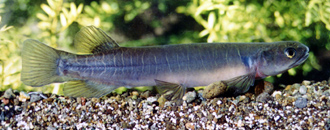 |
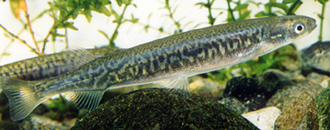 |
| |
|
Endemic banded kokopu are the smallest whitebait, but mature to 20 cm or more in length. Whitebaiters call them "golden bait" because of their golden colour as whitebait. Juveniles are excellent climbers able to move upstream to small tributaries with forest canopy cover, but do not go very far inland. A distinguishing feature is early development of light vertical bands that remain through adulthood, which are also on young giant kokopu.
 MORE MORE |
|
|
Inanga are one of two Galaxiids that are not endemic. The whitebait are caught more than any other because they make up most of the catch. An adult is the smallest of the whitebait species, seldom more than 11 cm long. Inanga is one of the most widespread freshwater fish, with the best distribution around most coastlines. With a preference for streams, rivers, lakes and swamps near the coast, and poor climbing ability, inanga do not penetrate very far inland.
 MORE MORE |
|
| |
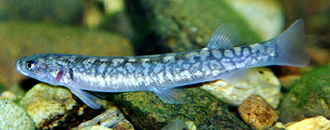 |
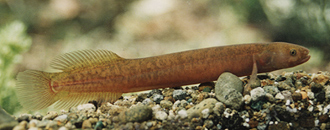 |
| |
|
The slender and elongate koaro is the most attractive of the 5 amphridomus whitebait Galaxiids, and one of only two that is not endemic. It is one of the most widely distributed native freshwater fish, with a high concentration on the South Island west coast. Unlike inanga, it penetrates further inland into its' preferred habitat of fast rocky streams in native forest, and is the most successful of the three whitebait species that form inland land-locked populations.
 MORE MORE |
|
|
All five New Zealand Neochanna species are endemic, and are specialised inhabitants of swamps, drains and forest ponds which may dry up in summer. Threatened brown mudfish which often grow to 17 cm long, can aestivate for months, to survive in damp ground during periods of seasonal drought. Distribution is limited to the Taranaki coast from Opunake south, from Pahiatua south to Wellington, and the west coast of the South Island from Karamea to Okarito.
 MORE MORE |
|
| |
| |
|
Distribution of black mudfish is in isolated relict populations in the northern North Island from north of Kaitaia, to the Arapai Swamp in the Mokau River catchment southwest of Te Kuiti. It has disappeared due to widespread habitat loss of many lower Waikato, Hauraki Plains and Hikurangi swamplands. Large mudfish populations remain in two of New Zealand's biggest freshwater wetlands, Kopuatai Peat Dome, and Whangamarino Wetland in northern Waikato. |
| |
 |
| |
|
|
|
|
| 2012 New Zealand Threat Classification System
Bignose galaxias
Galaxias macronasus
[5] Gradual decline
Black mudfish
Neochanna diversus
[5] Gradual decline
Brown mudfish
Neochanna apoda
[5] Gradual decline
Canterbury mudfish
Neochanna burrowsius
[2] Nationally endangered
Chatham mudfish
Neochanna rekohua
[7] Range restricted
Dune Lakes galaxias
Galaxias sp.
[3] Nationally vulnerable
Dusky galaxias
Galaxias pullus
[5] Gradual decline
Dwarf galaxias
Galaxias divergens
[5] Gradual decline
Eldons galaxias
Galaxias eldoni
[3] Nationally vulnerable
Flathead galaxias
Galaxias depressiceps
[5] Gradual decline
Giant kokopu
Galaxias argenteus
[5] Gradual decline
Gollum galaxias
Galaxias gollumoides
[5] Gradual decline
Lowland longjaw galaxias
Galaxias cobitinis
[1] Nationally critical
Northland mudfish
Neochanna heleios
[2] Nationally endangered
Roundhead galaxias
Galaxias anomalus
[5] Gradual decline
Shortjaw kokopu
Galaxias postvectis
[6] Sparse
Upland longjaw galaxias
Galaxias prognathus
[5] Gradual decline |
|
|

